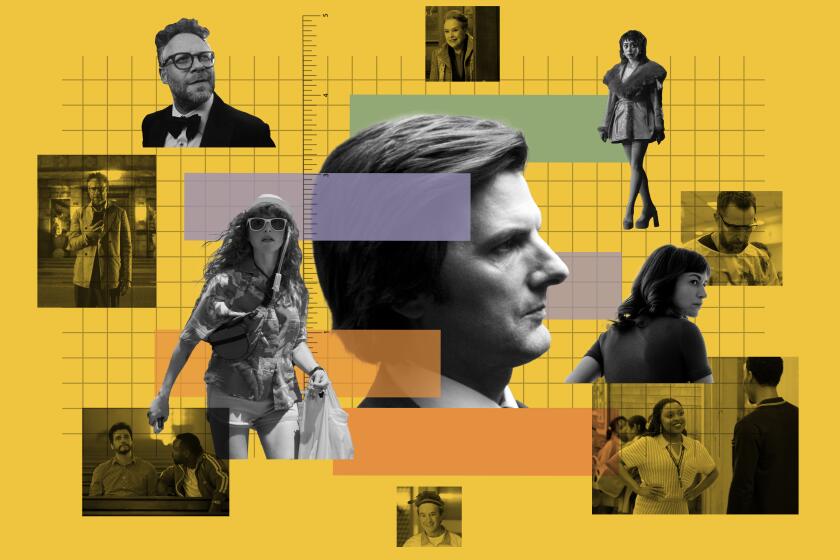
- Share via
Linda Lavin has never won an Emmy.
That may surprise you, particularly if you were around when Lavin headlined the long-running CBS sitcom “Alice,” in which she played a widowed mom working as a waitress while pursuing her dream of singing. The series ran from 1976 to 1985, piling up more than 200 episodes, a spinoff for Polly Holliday (Flo, the “kiss my grits” sass-flinger) and a lasting reputation for presenting an early, understated feminist role model. Alice wasn’t nearly as brash as Bea Arthur’s Maude or quite as lovable as Jean Stapleton’s Edith Bunker, but like her contemporary Mary Tyler Moore, she could turn the world on with her smile.
Lavin, who died in December at 87, did earn two Golden Globes for the role and, after “Alice” ended, she won a Tony Award in 1987 for lead actress in a play for her turn as a Jewish mother navigating a changing world in Neil Simon’s “Broadway Bound.”
“It was one of the greatest stage performances I have ever seen, and I told her that the first day I met her,” says Nathan Lane, who had the opportunity to share his enthusiasm with Lavin when they worked together on the Hulu sitcom “Mid-Century Modern.” Lane recalls watching the play and choking up when Lavin absent-mindedly wiped off a phone receiver — her character was always cleaning — right after a wrenching phone call.
“She could do anything and make it look effortless,” Lane says. “Working with her was the happiest experience I’ve ever had in television.”
“Mid-Century Modern” showrunners Max Mutchnick and David Kohan had considered a few women for the role of Sybil Schneiderman, mother of Lane’s character, Bunny — one of three gay friends who decide to live together, following the death of a fourth, in a Palm Springs home also occupied by Sybil. That living arrangement produces some friction and good-natured barbs, but Sybil, as played by Lavin, always leads with love and a generous spirit. And, of course, she’s funny. Veteran sitcom director James Burrows calls Lavin a “heat-seeking missile for a joke.”
Our panel of Emmy experts picks who’s in, who’s out and who’s on the bubble as the 2025 campaign gets underway.
Anyone watching was very much in on the fun. When Lavin was revealed as Bunny’s mother in the first episode, the studio audience was so happy to see her that Burrows had to stop the scene because they were cheering so loudly.
“It took a few tries to finally get it right,” Mutchnik says. “People always referred to Linda as sitcom royalty, and we quickly found out that that was true.”
Lavin had completed filming seven episodes of “Mid-Century Modern” when, in December, she told Kohan and Mutchnik that she had lung cancer and would be undergoing radiation treatment. The prognosis, she said, was good, and she encouraged them to write her illness into the show, should she be limited. Lavin died Dec. 29.
“I had spoken to her the day after Christmas,” Lane says. “We were supposed to be back in a week to film the last three episodes, and she was feeling very positive and optimistic.” He pauses. “I’m getting too emotional.” Another pause. “At least I was able to tell her how much I loved her.”

Lane was afforded another chance to express his feelings when the cast and crew reconvened in January to shoot the episode addressing Lavin’s demise. Titled “Here’s to You, Mrs. Schneiderman,” the half-hour finds Lane’s Bunny recounting Sybil’s death, using details that mirrored Lavin’s own passing.
On that December day, Lavin’s husband, Steve Bakunas, had been driving her to the hospital, with Lavin admonishing him not to speed. After saying “I love you,” Lavin’s last words were: “Live your life.”
“The only way we could write this and honor her was to tell the truth,” Kohan says, adding that Bakunas had given them his blessing. In a way, he notes, Lavin had too with her directive to incorporate her diagnosis into the show.
Kohan says he took some solace in the fact that Lavin was able to say goodbye and was spared having to battle cancer that had metastasized in both lungs. And yet ...
After years of shows like ‘Schitt’s Creek,’ ‘Succession’ and ‘The Bear’ running the table, the 2025 Emmy race features a bumper crop of first-timers poised to break through.
“You have to understand that I had spoken to her two days before and she was so vital and so present,” he adds quietly.
“She also told us, ‘Steve and I have said everything we need to say to each other’ and that they had done the work,” Mutchnik says. “She said she had a few dreams for her life. One was a work situation where she was happy, and she loved the work and the work loved her. One was to be in love with the right man — and she was — and she wanted to live in Malibu, and that is where her life ended. So she had everything she wanted.”
In Emmy history, 33 actors — 22 men and 11 women — have been posthumously nominated. Most recently, Treat Williams earned a nod last year for his supporting turn in the FX limited series “Feud: Capote vs. the Swans.” Ray Liotta was nominated in 2023 in the same category for “Black Bird.” And in 1978, Will Geer received three posthumous nominations, including his last season on “The Waltons.” (He lost all three.)
Lavin has a legitimate case. She elevates “Mid-Century Modern” every time she’s onscreen with her vitality and comic timing. In April, she picked up a comedy supporting actress nod from the Gotham Television Awards.
“I really hope she’s considered,” Mutchnik says. “She so f— deserves it. Her work in those episodes is incredible, the best of what the medium can offer.”
Adds Kohan: “She was such a beloved figure, partly because of the way she loved other people. In our little world, for everyone in front of and behind the camera, she was the momma of the place. We were lucky to have her.”
More to Read
Sign up for The Envelope
Get exclusive awards season news, in-depth interviews and columnist Glenn Whipp’s must-read analysis straight to your inbox.
You may occasionally receive promotional content from the Los Angeles Times.












